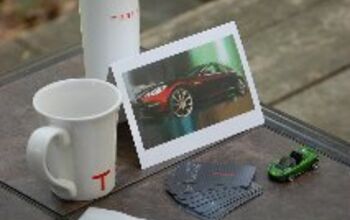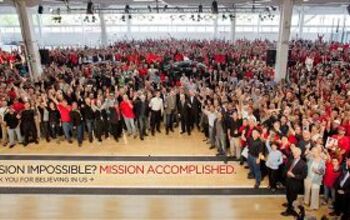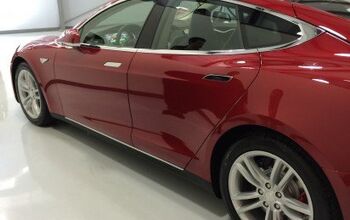Tesla Model S Customer Begins Blog for TTAC
A four-door sedan is not my kind of car. I need space in the back for mountain bike, dog, golf clubs–on occasion, all three. I currently drive a Mazda CX-7, which has the space, plus the bonus of snappy handling and zoom-zoom pick-up. But as a green kind of guy, I’ve followed the Tesla saga from the beginning, and the S seemed like a very cool car. I had recently started thinking seriously about buying an electric car, something I could power with a small hydroelectric generator I’m installing on the creek that runs by my house in upstate New York. So when I read that a prototype Model S would appear at the Plaza Hotel in New York City last spring, I decided to drive the Mazda down and learn something about electric cars, and see if the S looked as good in the flesh as it did in the press-release photos.
It did. Feline and gracefully sculpted, the S fit right in among the high-end BMWs, Maseratis and Bentleys that paraded past the hotel entrance. Two Plaza doormen I talked to—guys who see hundreds of ultra-expensive cars every day—were impressed. “It’s gorgeous,” one of them told me. “Are you sure it only costs $49,000? Looks like a $100,000 car to me.”
Unfortunately, the Model S on display at the Plaza was strictly for show; it had no motor, battery, or even an interior. (Hence, the blacked-out windows.) So I couldn’t drive it, or even sit in it. But I was at least able to kick the tires, rub my hand over its aluminum fenders, and look at it from all angles. Studying the car from the rear, I was surprised to see that it appeared to have a hatchback, and a pretty wide one at that. A light dawned. If the rear seats folded down, it might be possible to get my mountain bike in back without removing the front wheel–the sine qua non of any car that I buy.
I asked the Tesla rep about it. He smiled. “Absolutely, you can put a bike in the back without taking off the front wheel. That was one of the original design criteria for the car.” In fact, he told me, the Model S’s rear cargo area (with back seats folded down) would swallow a bike, surfboard, and 50-inch flat screen TV–simultaneously.
Holy shit. All of a sudden, this was the perfect car for me: electric, cool-looking, good performance, lots of space. It took about a week to get up the nerve to actually write the $5,000 deposit check and send it off. I assured my wife that the deposit was refundable, for any reason, at any time. And it would be a good, safe investment—the zero interest rate I’d be getting on the deposit was a lot better than my mutual funds have been doing recently. Projected delivery date was late 2011.
My sequence number is P 717, which puts me on the low-priority waiting list, behind the 1,000 rich guys who pay a $40-K deposit to reserve a special Signature Edition (price not yet determined), and behind current owners of the two-seat Tesla Roadster sports car, who get to jump the queue for the first standard production versions of the S. I don’t mind being shunted to the rear; let them get some of the production bugs out by the time they get to me. In any case, I’ll probably be among the first 3,000 customers to take delivery.
For now, the major bennie of being a Model S owner is the chance to test-drive a Roadster. I called Joe Powers, Tesla’s East Coast sales rep out of New York, who quickly set me up for the drive. A half-hour spin around Manhattan at rush hour is no way to test a high-performance sports car, but I just wanted to get a feel for what it was like to drive an electric car. The feel is, in a word, extraordinary.
Many people believe electric cars will someday revolutionize everyday driving. But after experiencing first-hand the seamless, effortless, head-snapping acceleration of the Roadster, I predict electric cars will revolutionize performance driving as well.
Acceleration is the way most of us judge a car’s performance. (Hey, let’s floor it and see what she’ll do! ) But it is not so much the quantity of the Roadster’s acceleration that’s so mind-boggling—zero to sixty in 3.9 seconds—but rather the quality of it. Flooring the Roadster triggers an instantaneous leap forward, almost before you’re ready. There’s no revving and popping the clutch, no shifting, no turbo lag, no lag of any kind. The car seems to be an extension of your right foot. Press down, go fast. Now.
For that extraordianary responsiveness, thank the torque characteristics of electric motors, which achieve their maximum torque at zero rpm. Internal combustion engines (ICEs), on the other hand, must typically rev up to 3,000 or 4,000 rpm to reach the peak of their torque curve. My CX-7, with its turbocharger and direct injection, can deliver peak torque as low as 2,000 rpm, which is one reason it’s so responsive to my right foot.
But in terms of instant response and seamless acceleration, the Tesla Roadster, with max torque from the first fraction of a second, inhabits an entirely different sphere. It made the CX-7 seem hesitant and plodding by comparison. I am no high-performance supercar driver, but I would discourage any Corvette or Ferrari owner from a test drive in a Tesla Roadster. You’ll never be satisfied with your car’s acceleration again.
One thing I didn’t like about the Roadster’s electric powertrain: the excessive engine braking when you back off the accelerator. Take your foot off the gas at 40 mph, and the car slows drastically, as if you were still in first gear in an ICE-powered car. That’s fine for racing or high-performance driving on twisty roads, but it’s annoying in normal driving.
Tesla programs the car this way to maximize regenerative braking, which turns the motor into a generator and charges the battery as the car slows. The Roadster’s brake pedal operates only the mechanical brakes, which waste kinetic energy by turning it into heat. To minimize this energy loss, Tesla engineers discourage drivers from using the brake pedal by building in the extreme regen engine braking.
It’s a lousy system. The Prius is much smarter: the brake pedal actuates the regenerative braking system, automatically supplementing with the mechanical brakes only as needed in hard stops. The built-in regen braking that occurs when you back off the pedal in the Prius is set to replicate normal ICE engine-braking feel. The Prius system is both more efficient and nicer to drive.
Memo to Tesla engineers: upgrade the Model S to pedal-activated regen braking, like the Prius. Then add driver-programmable built-in regen engine braking. Give us a toggle switch on the steering wheel with, say, five positions to select five levels of built-in regen engine braking when you back off the gas pedal. For high-performance driving, pick Level 1 or 2, the eqivalent engine-braking feel of an ICE engine in first or second gear. Levels 4 and 5 would simulate the more gradual engine-braking feel of higher gears. And why not add a sixth “coast” position, which essentially turns off the built-in regen braking?
Model S owner bennie No. 2 was an invitation to the opening of Tesla’s New York store in July. Located on West 25th St. in the oh-so-hip Chelsea district, the showroom is literally in the shadow of the High Line, the long-abandoned elevated railroad bed that’s been converted to a stylish park-in-the-sky. The event felt like an art gallery opening, with young, artsy people, wine in hand, spilling out onto the sidewalk, where several Roadsters glistened under the streetlights. Every few minutes, somebody would hop in to one of them and charge off for a three-minute spin literally around the block. (One guy, grinning madly, claimed he got up to 85 mph.)
But the bennie I’m really hoping for one of these days is a chance to test-drive a Model S test mule and actually offer some meanigful feedback to Tesla engineers. Stay tuned.
More by David Noland
Latest Car Reviews
Read moreLatest Product Reviews
Read moreRecent Comments
- ToolGuy TG likes price reductions.
- ToolGuy I could go for a Mustang with a Subaru powertrain. (Maybe some additional ground clearance.)
- ToolGuy Does Tim Healey care about TTAC? 😉
- ToolGuy I am slashing my food budget by 1%.
- ToolGuy TG grows skeptical about his government protecting him from bad decisions.


































Comments
Join the conversation
Doug: Very convincing and thorough information, thank you for it. I had forgotten that in ships, and in cars, we have limits to the temperature and other operating paremeters, and that these weigh on the choices available. Also good point about the energy required to refine and transport crude and its gasoline (or whatever) end product. True, some energy is required for coal mining, refinement and transportation, but far less than for petroleum. It's great to hear points that suggest that at least SOME of that pie in the sky might really land on our plates. I'll be much less cynical going forward.
A Tesla Roadster Owner already has a blog: http://teslaowner.wordpress.com/